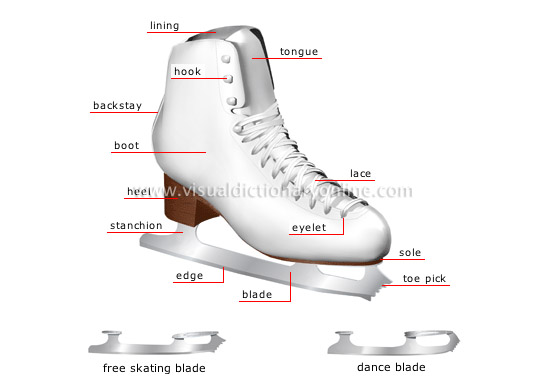figure skate
Reinforced boot with a blade that makes it possible to glide over the ice; figure skating is hard on the ankles so the skate provides maximum ankle support.
toe pick 
Small teeth at the front end of the blade; they serve as the pivot point during spins and also make it possible to take off and land during jumps.
sole 
Sturdy plastic or wooden sole that forms the bottom of the boot; the blade screws into the sole.
eyelet 
Small metal-rimmed hole through which the lace passes.
lace 
Narrow cord of fabric or leather, flat or round, that is threaded through eyelets or hooks to tighten the boot.
hook 
Small piece of curved metal used to attach the lace.
blade 
Narrow tapering strip of metal that is attached to the sole; the lower part is made of hardened steel to keep the edges sharp.
edge 
Part of the blade that bites into the ice; the blade has two edges (inside and outside), which are separated by a groove.
stanchion 
Vertical part that extends up from the blade to secure it to the sole.
heel 
Stiff part underneath the boot that supports the back of the foot.
boot 
Sturdy flexible boot with a lace; it protects and supports the foot and ankle and is made of leather or synthetic materials.
backstay 
Reinforcement at the back of the boot.
lining 
Padded layer of fabric or leather that covers and protects the inside of the boot.
tongue 
Piece that extends from the boot and prevents the foot from rubbing against the lace; it is lifted to slip the foot into the boot.
dance blade 
Blade whose heel is shorter and whose toe picks are less pronounced to facilitate the execution of complex movements and to prevent the toe picks from catching.
free skating blade 
Blade with toe picks that facilitate the execution of jumps and spins; its curvature is more pronounced than that of the dance blade.











